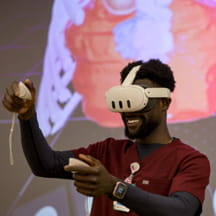Diagnosed in utero with renal failure and multiple congenital anomalies, Evan Beier is no stranger to the inside of an operating room. Undergoing 80-plus procedures before the age of 11 comes with its own challenges.
His parents and medical caregivers developed a plan to address these challenges head on to help Evan overcome them. “We wanted to be really mindful of his whole-body health,” says Alison, Evan’s mother.
Starting young
When Evan was 4 years old, he started with play therapy to help process and understand his life in and out of the hospital. His parents wanted him to start therapy early, but they struggled to find play therapists in the area who dealt with medical trauma.
However, the UCLA Nathanson Family Resilience Center (NFRC) was able to fill in the gaps. “We really lucked out,” says Alison. “The center is there for families just like us.”
For four years, Evan and his family went through the Family Resilience Training program until they eventually graduated from the program. With a better understanding of Evan’s needs, thoughts and feelings, they were all better equipped for the road ahead.
Outlining a care plan
Medical-related trauma associated with going under anesthesia meant Evan had growing anxiety and distrust before each procedure. Following graduation from the NFRC program, Evan regained trust and found a plan that worked.
To regain control, Evan and the child life specialists at UCLA Mattel Children’s Hospital in Los Angeles set up a stringent plan to follow every time he goes under anesthesia. Before the doctors can push the Propofol, Evan chooses a number to count down from and says goodbye to his mom, and then the oxygen mask is placed after he’s asleep.
“The team at UCLA has been just amazing,” says Alison. “It’s all according to the parameters that work for him, and they’re such great advocates for him.”
Now, Evan also has a port-a-cath, which is accessed at the infusion center so he can check in to the hospital a bit later ahead of any procedures. With about two procedures each year, the child life team streamlined check-in to make Evan more comfortable. “He's my hero,” Alison says. “He's just tremendous. He's resilient and he takes it all in stride.”
Embracing time together
The Beier family has learned to take each day in stride. Addressing trauma and mental health challenges has just been one aspect of Evan’s health care, and the road ahead isn’t as clear. With regular biopsies and tests, sometimes Evan’s care must change—for better or worse. This brings on a new season, new routines and new concerns for the family.
“The pandemic and Evan’s current care plan is just a new season of life,” says Alison. “We don’t always know how long the seasons will last, and we don’t know what they’ll bring.”
With fewer constraints on where to be and when, the Beier family has appreciated more time at home and more time together throughout the COVID-19 pandemic. “We just got to be with each other and love on each other and really grow as a family,” Alison says. “It’s been really beautiful for us.”



